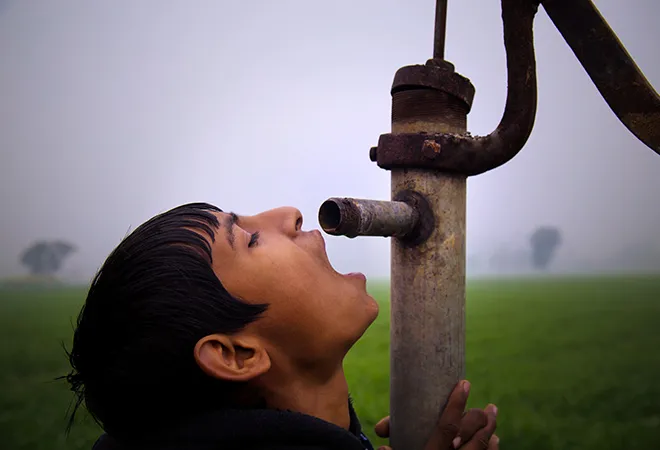 This article is part of the series — Post-Pandemic Development Priorities.
This article is part of the series — Post-Pandemic Development Priorities.
After achieving arguably its biggest success in people-centric development initiatives through the Swachh Bharat Abhiyan, the Modi government has geared up to provide tap connections to every rural household in India. The Jal Jeevan Mission seeks to provide every rural household with a Functional Tap Connection (FHTC) by 2024, such that drinking water is made available in the prescribed quality and regularity in lieu of affordable service delivery charges. Within a year since the project began, more than 180,000 habitations across all the states and UTs have claimed to have become ‘har ghar jal’ habitations with 100 percent FHTC coverage. This project reinforces India’s commitment for meeting SDG 6, which is to provide clean water and sanitation to all.
A subcontinent-sized country like India presents a mosaic of challenges — and opportunities — emanating from diverse climatic conditions, topography, settlement pattern, water endowments, general state of development and the ensuing environmental footprint, seasonal hazards, cultural practices, and preferences. In order to ensure long-term sustainability, any centrally conceptualised plan and programme needs to go beyond a one-size-fits-all approach and remain flexible to modifications incorporating regional diversity. A programme like the Jal Jeevan Mission needs to take into cognizance the localised diversity and remain flexible in its planning and implementation processes. The Mission needs to encourage a bottom-up, participatory and an inclusive approach to planning and implementation such that the newly laid piped systems dovetails with the region-specific attributes. In that way, slippages and exclusions, due to acts of omission and commission, could be minimised and the goal of universal access to safe and reliable drinking water though piped connection could be achieved.
Any centrally conceptualised plan and programme needs to go beyond a one-size-fits-all approach and remain flexible to modifications incorporating regional diversity.
In the remaining part of the article, we highlight some of the diversities that characterises the Indian landscape and argue for a bottom-up, flexible, inclusive, and participatory planning and action.
The central India highlands, home for most of the tribal population of the country, is characterised by a rugged landscape and a dispersed settlement pattern. Even in villages with a mixed population, the tribal settlements could be dispersed and away from the village centre where the non-tribal population would reside. Given such a settlement pattern, a piped network that is centrally located and managed could be an economically strenuous proposition. There is every possibility that during the planning-implementation process, either the tribal habitations get left out or the design of the distribution network puts them in a particularly disadvantageous position. Either way, this raises concerns around equitable distribution, especially during times of water stress. To ensure universal access in such a setting, taking cognizance of localised heterogeneity right at the inception stage, becomes an essential prerequisite. This then needs to be followed-up with a plan which is well-suited to the local environment. Such a plan can only be prepared by harnessing the knowledge and understanding of the locals and by involving organisations familiar with the terrain through an inclusive and participatory process.
In the alluvial floodplains of North, East and Northeast India, the communities might have an advantage in terms of quantum of water availability but their ordeals stem from an annual cycle of flooding, creating a situation akin to ‘Water, water, everywhere, nor any drop to drink.’ As it exists today, a bulk of the drinking and domestic water needs in this region is met by drawing water from shallow aquifers by means of handpumps, which become dysfunctional during the flooding season. Flooding may also contaminate the shallow aquifers and the stagnant, disconnected sources of surface water. Therefore, the challenge for the Mission is to provide safe water supply round-the-year to densely populated habitations that are routinely exposed to the seasonal hazard of floods. Overcoming this challenge will entail timely and periodic refurbishment of the existing sources along with localised design innovations that are resilient in the face of the recurrent seasonal hazards. Operationally that gets translated in the form of elevated hand-pumps and elevated tap connections, taking into account the Highest Flood Level (HFL), observed locally. Again, an inclusive and participatory planning process, that encourages local innovations that are in sync with local realties are an important prerequisite for designing resilient infrastructure.
The challenge for the Mission is to provide safe water supply round-the-year to densely populated habitations that are routinely exposed to the seasonal hazard of floods.
Universal access to safe and reliable drinking water through piped connections is dependent on the sustenance of the water source. Here, again, one faces a diverse set of challenges in diverse locations. Large parts of the country reel under pollution — both from geogenic sources as well as from anthropogenic sources. Choosing an appropriate source — that is not exposed to geogenic or anthropogenic contamination — is a necessary pre-requisite for universal access to safe water. Granular mapping of the state of the source, an aquifer system, or a river system, in terms of its depletion and contamination, is essential for the larger purpose of source sustainability. This becomes even more crucial in hilly and mountainous landscapes, such as the Indian Himalayan region and the Western and Eastern Ghats, where the dependence on a single source of water, like a spring, is paramount. Here to ensure sustained universal access, the Mission needs to focus on source augmentation and source management. Hence, in a mountainous landscape, the Mission has to encourage conservation of springs through a decentralised springshed management approach.
The government needs to be lauded for taking up such a basic yet ambitious goal. But the success of the Jal Jeevan Mission will remain contingent upon the ability of the programme to remain flexible. The centralised financial resource should be amenable to a community-based and decentralised planning and implementation process. The success of the Swachh Bharat Abhiyan is partially attributed to the involvement of the community and non-governmental actors at various stages of the project. Now the Jal Jeevan Mission also needs to take cognisance of the local diversity, go beyond the minimalist visualisation of pipelines and tap connections and encourage local innovations. Community involvement and involvement of non-governmental organisations, matched with adequate funding, will be necessary if the Mission has to achieve and sustain its development goals.
The views expressed above belong to the author(s). ORF research and analyses now available on Telegram! Click here to access our curated content — blogs, longforms and interviews.



 This article is part of the series —
This article is part of the series —  PREV
PREV



